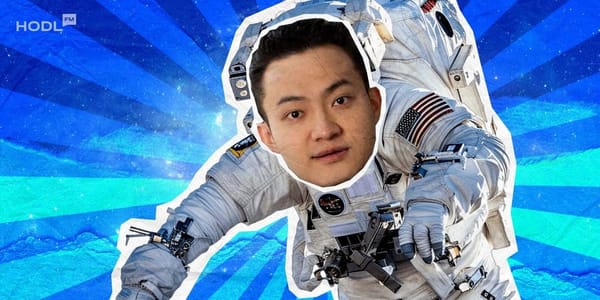The fusion of artificial intelligence and blockchain, often called crypto AI, is unlocking a new era of crypto innovation. In 2024–2025, the best AI crypto coins drew growing attention from investors and developers exploring the potential of decentralized, intelligent networks. As artificial intelligence gains broader adoption, the total market cap for AI-focused crypto projects reached nearly $27 billion as of October 2025, and the trend is accelerating.
As someone who’s watched both AI and crypto explode over the past few years, I can say that the current wave of projects feels like a genuine leap forward, much more than the hype cycles of 2017 or 2021.
How AI is transforming the crypto ecosystem
AI crypto projects bring machine intelligence to decentralized platforms. These projects enable:
- Decentralized AI services: For example, a protocol like SingularityNET provides a decentralized marketplace where anyone can publish, discover, and use a wide variety of AI algorithms and models. It functions like an "App Store" for AI, where developers can earn money by offering their creations, and users can integrate these AI services to solve their tasks.
- Crowdsourced AI networks: For instance, Bittensor, a network where numerous artificial intelligence models "communicate" and learn from each other. Network participants provide their computing resources and models, which compete to solve tasks. The best and most useful models receive rewards in the project's cryptocurrency (TAO). In this way, the network collectively creates and improves a decentralized "brain" through competition and collaboration.
- Data marketplaces: Notably, Ocean Protocol allows data owners to sell access to their data without actually transferring the data itself. This solves the problem of confidentiality. For example, an AI model can "come" to the data, train on it, and "leave," while the data itself remains with the owner. So, Ocean allows companies and researchers to securely monetize their datasets or purchase access to them for model training.
- AI-Powered infrastructure: In fact, training complex AI models requires very powerful and expensive computers (GPUs). Take, for example, Render Network and Akash Network created decentralized marketplaces where people around the world with idle GPU capacity can rent out their resources to those who need them. This makes computing resources more affordable and accessible compared to centralized providers like Amazon Web Services.
- On-chain AI agents: Fetch.ai and Virtuals Protocol created the infrastructure for Autonomous Economic Agents (AEAs) – AI-powered software bots that can act independently on the blockchain. Such an agent could, for example, analyze market data and automatically trade, book services, or manage resources on your behalf.
- AI in finance: One illustration is Numerai, a hedge fund, with an unusual approach. It provides encrypted financial data to thousands of anonymous data scientists worldwide. These scientists build machine learning models to predict the stock market. The best models are sent to Numerai, which combines them into a single model for making trading decisions. Participants whose predictions are successful receive rewards in the cryptocurrency NMR.
If you’ve ever tried using an AI-powered wallet or tested an on-chain data market, you know how quickly these tools are moving from experimental to essential.
Top 10 AI crypto coins in 2025
With dozens of AI-related crypto projects launching every year, it can be challenging to separate the hype from real technological progress. The following list highlights the standout tokens and ecosystems in 2025, including leading layer AI crypto projects, each selected for its unique approach to integrating artificial intelligence and blockchain, market momentum, and real-world use cases. If you’re new to the space, don’t worry, these highlights focus on real utility, not just speculative hype.
Bittensor (TAO)
Bittensor is one of the main projects in the decentralized AI movement. It's unique because of "Proof of Intelligence" consensus mechanism. And, instead of being a static marketplace to simply buy and sell AI models, Bittensor functions as a dynamic, global Peer-to-Peer market for machine intelligence. In this ecosystem, contributors connect their machine learning models to the network, where they compete to provide the most accurate and valuable outputs in response to queries. The quality of these contributions is evaluated by the network, and the best-performing models are rewarded with TAO tokens. This approach creates an incentive for improvement, allowing the entire network to evolve into a collectively smarter "AI brain."
The ecosystem is structured into specialized "subnets". Each is dedicated to a different AI domain, such as text generation, data analysis, or image creation. The TAO token is central to the network's operation, serving as a reward for miners, for staking with validators to secure the network, and for participating in governance to vote on the protocol's future. This model has captured institutional attention, highlighted by the fact that digital asset manager Grayscale has officially launched the Grayscale Bittensor Trust (GBTC).
According to CoinGecko, as of late 2025, Bittensor's native token, TAO, has a circulating supply of approximately 9.5 million with a market capitalization of around $3.9 billion.

The Artificial Superintelligence (ASI) Alliance
In 2024, Fetch ai crypto, SingularityNET, and Ocean Protocol announced plans to form the Artificial Superintelligence (ASI) Alliance. The goal was to merge their tokens FET, AGIX, and OCEAN – into a single ASI token, creating a powerful ecosystem to challenge the dominance of Big Tech in AI development.
However, in October 2025, the alliance shifted when Ocean Protocol officially withdrew from the merger to pursue its independent roadmap. As a result, Fetch.ai and SingularityNET are moving forward as a duo, continuing their integration, while Ocean Protocol re-establishes its token and market independence.
Currently, the combined alliance's token continues to trade under the FET ticker pending the final rebrand to ASI. Based on the current data, the FET token has a market capitalization of approximately $678 million. The price per token is approximately $0.26.
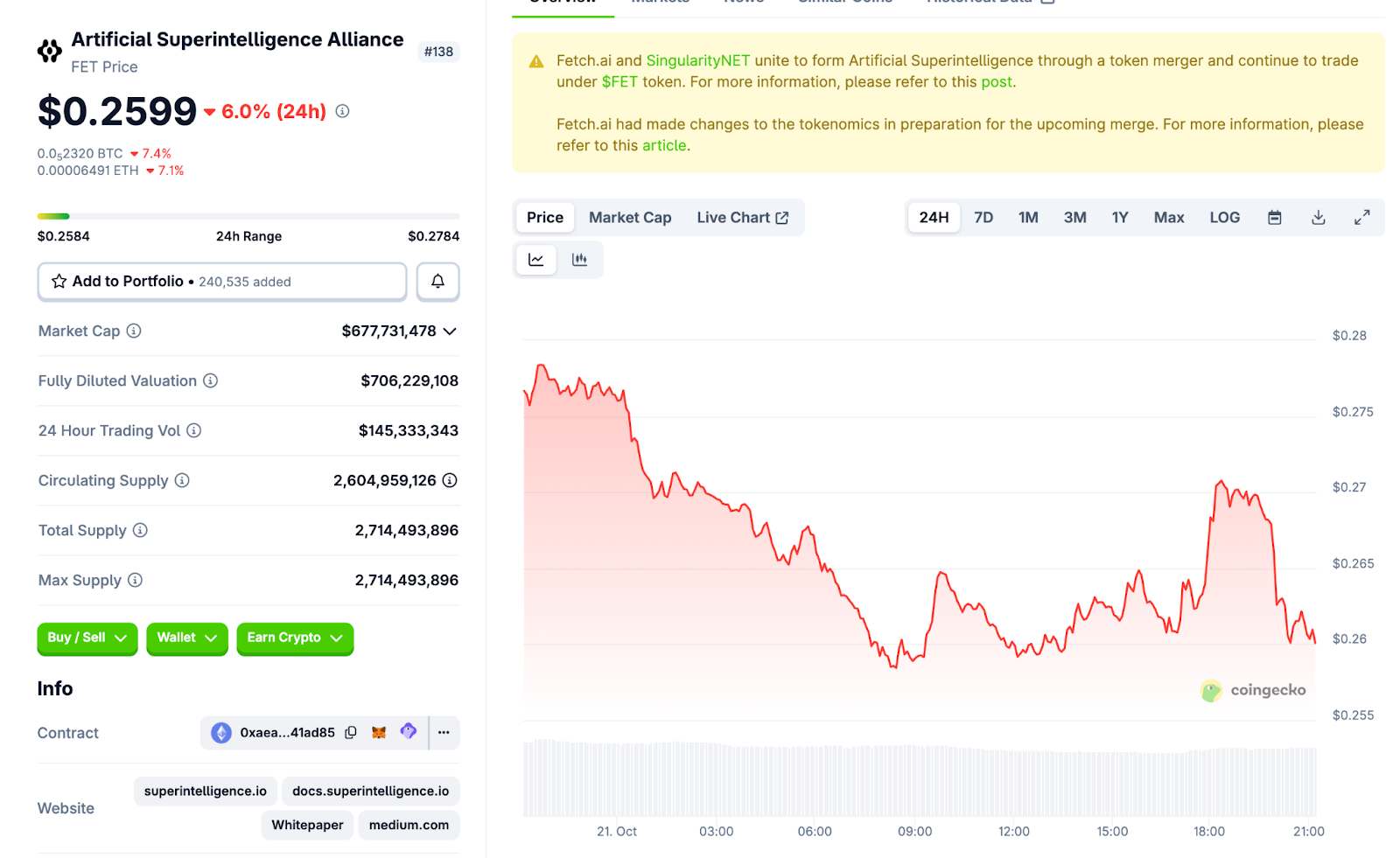
SingularityNET (AGIX)
SingularityNET is one of the foundational projects in decentralized AI. It was created as an open marketplace for artificial intelligence services. Led by the AI researcher Dr. Ben Goertzel, the platform allows developers to publish and monetize their AI algorithms, while users can browse and integrate these services into their own applications. This creates a global, permissionless kind of "mind-for-hire" network.
AGIX token has a market capitalization of roughly $32.7 million and a price of approximately $0.114 per token.

Ocean Protocol (OCEAN)
Ocean Protocol is a decentralized marketplace specifically for data. Its core mission is to let people and companies share or sell access to their data for AI training without sacrificing privacy. This is done through a technology called "Compute-to-Data," which allows an AI model to learn from a dataset without the data ever leaving the owner's server. After initially joining the ASI Alliance, Ocean Protocol withdrew in October 2025 to focus on its independent vision for a secure data economy. The OCEAN token is used to buy and sell data access on the marketplace.
OCEAN token has a market capitalization of about $53 million, with a price of approximately $0.26 per token.

The Graph (GRT)
The Graph is often called the "Google for blockchains." Its main job is to index and organize the massive amount of data on different blockchains, making it easy for decentralized apps (dApps) to find and use that data quickly and reliably. Without The Graph, dApps would be slow and inefficient. To make its service even smarter, the project is integrating machine learning to improve how data is queried and sorted. The GRT token is used by participants to ensure data accuracy and pay for queries on the network.
GRT has a market capitalization of around $701 million and a price of approximately $0.06 per token.

Render (RENDER)
Render Network solves a huge problem for both AI developers and digital artists: the need for massive, expensive computing power. It created a decentralized marketplace where anyone with a spare graphics processing unit (GPU) can rent out that power to those who need it for tasks like AI model training or creating complex 3D graphics. This makes high-performance computing much affordable and accessible. As the demand for GPUs for AI continues to skyrocket, Render provides a practical and scalable solution. The RNDR token is used to pay for computing jobs on the network.
$RNDR has a market capitalization of approximately $1.36 billion, with a price of around $2.62 per token.
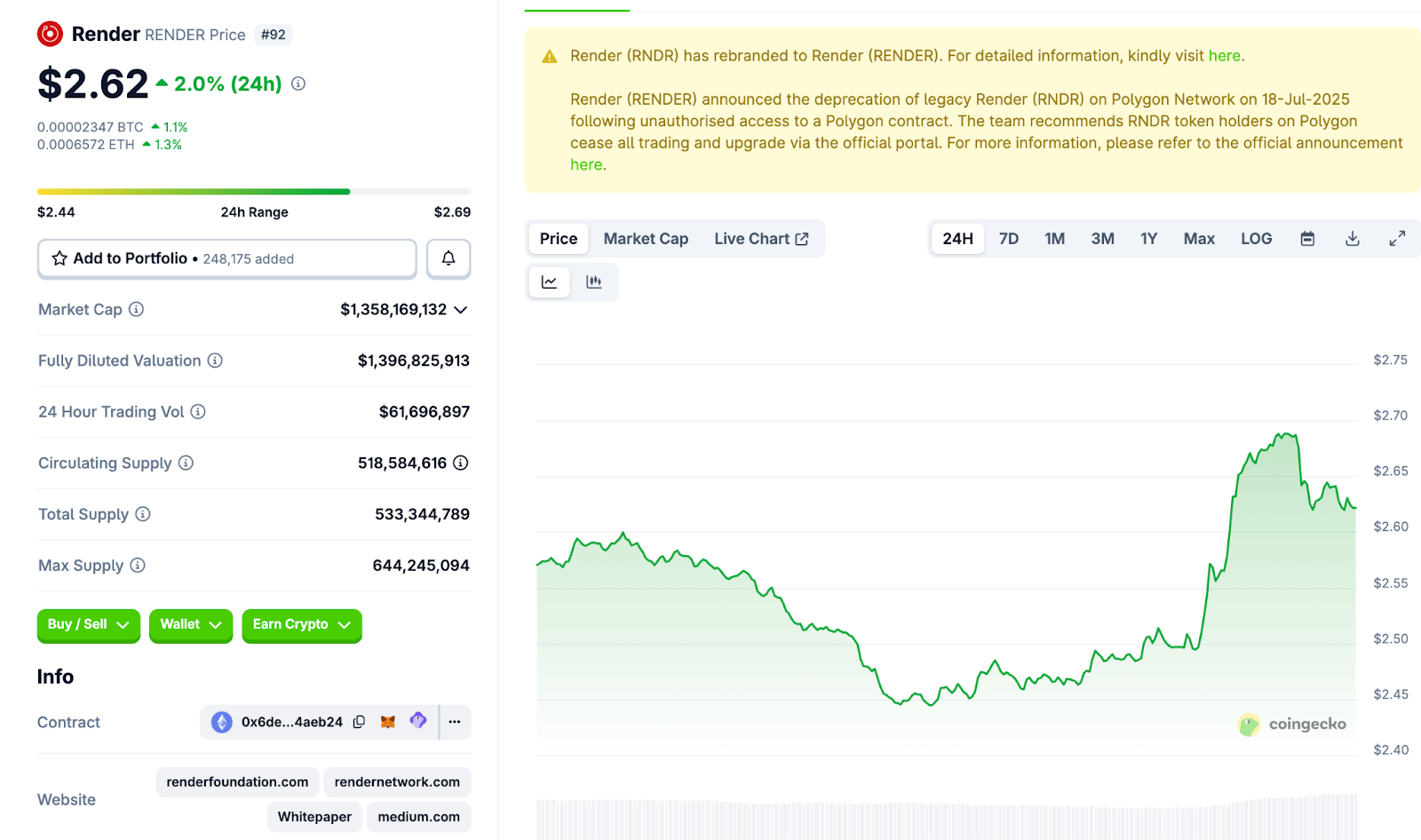
Numerai (NMR)
Numerai is a project that is both a hedge fund and a decentralized AI crypto trading platform. It provides thousands of anonymous data scientists around the world with encrypted financial data and challenges them to build AI models that can predict the stock market. The scientists stake NMR tokens on their models to show confidence in their predictions. Those with the most accurate models win more NMR, and Numerai combines the best predictions to power its actual hedge fund trading strategies. It's a real-world example of a crowdsourced, AI-powered financial system.
NMR has a market capitalization of about $107 million and a price of approximately $13.35 per token.

Akash Network (AKT)
Akash Network is building a "decentralized AWS" or an "Airbnb for cloud computing." It is an open marketplace where anyone can buy and sell computing resources, from CPU power to high-end GPUs needed for AI tasks. By allowing providers from all over the world to compete, Akash offers these resources at a significantly lower cost than traditional centralized providers like Amazon Web Services or Google Cloud. This makes it a go-to platform for developers and AI companies looking for affordable, permissionless access to computing power. The AKT token is used to pay for services on the network.
AKT has a market capitalization of around $195 million and a price of approximately $0.70 per token.
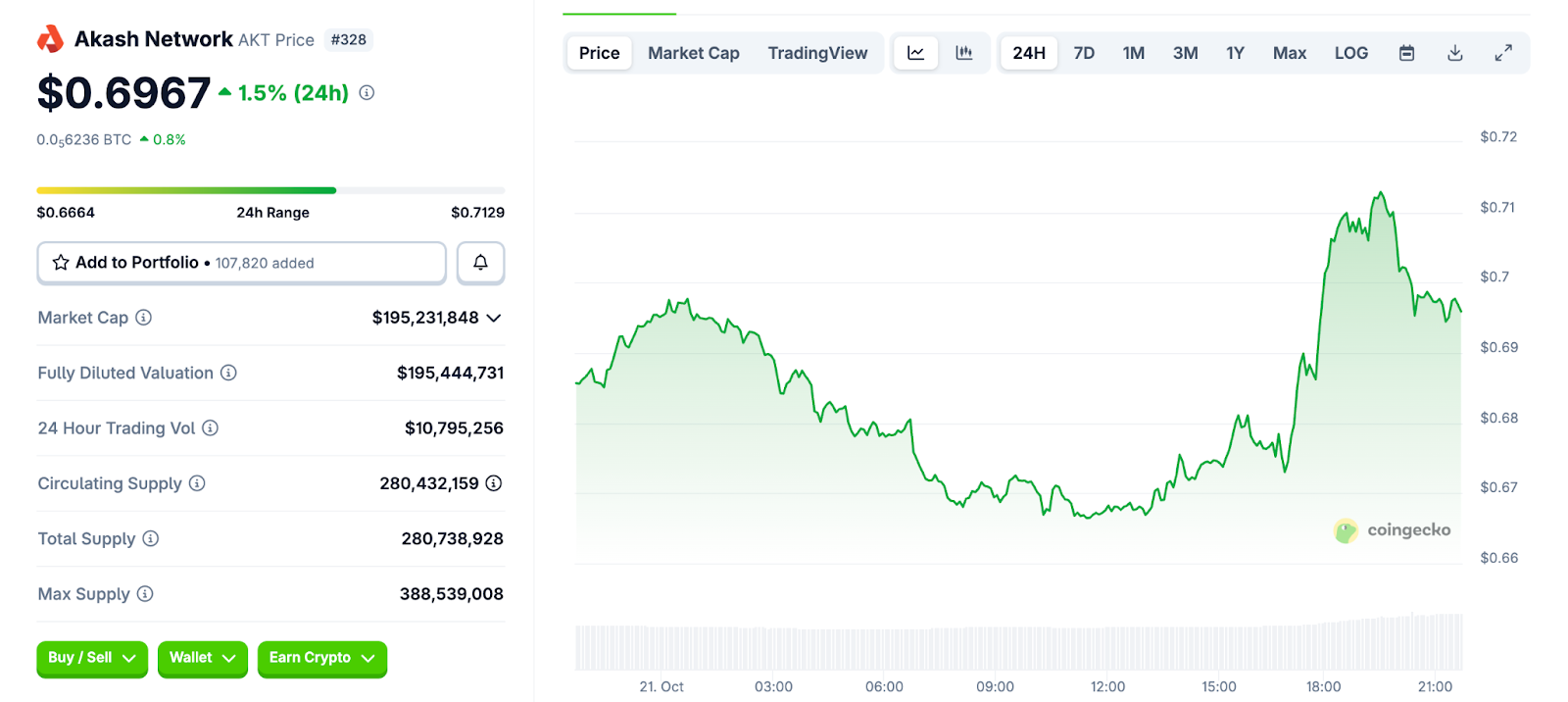
Alethea AI (ALI)
Alethea AI is bringing NFTs to life by making them intelligent. The project has developed a protocol to create "intelligent NFTs" (iNFTs), which are digital assets embedded with an AI personality. This turns a static image or avatar into an interactive character that can talk, learn, and perform tasks. Using technology like their CharacterGPT engine, Alethea allows anyone to create their own unique AI-powered digital beings for use in games, the metaverse, or as digital companions. The ALI token is used to create and upgrade these iNFTs.
ALI has a market capitalization of approximately $36.6 million, with a price of around $0.004 per token.

Virtuals Protocol (VIRTUAL)
Virtuals Protocol is pushing the boundaries of what AI can do on the blockchain by enabling the creation of fully autonomous AI agents. These are not just simple bots. They are independent on-chain entities with their own crypto wallets that can own assets, execute transactions, and provide services 24/7 without human control. Think of them as digital workers or decentralized businesses run entirely by AI. This technology opens up new possibilities for everything from automated financial services to managing complex digital organizations. The VIRTUAL token is used to create, power, and interact with these agents.
VIRTUAL has a market capitalization of about $539 million and a price of approximately $0.82 per token.
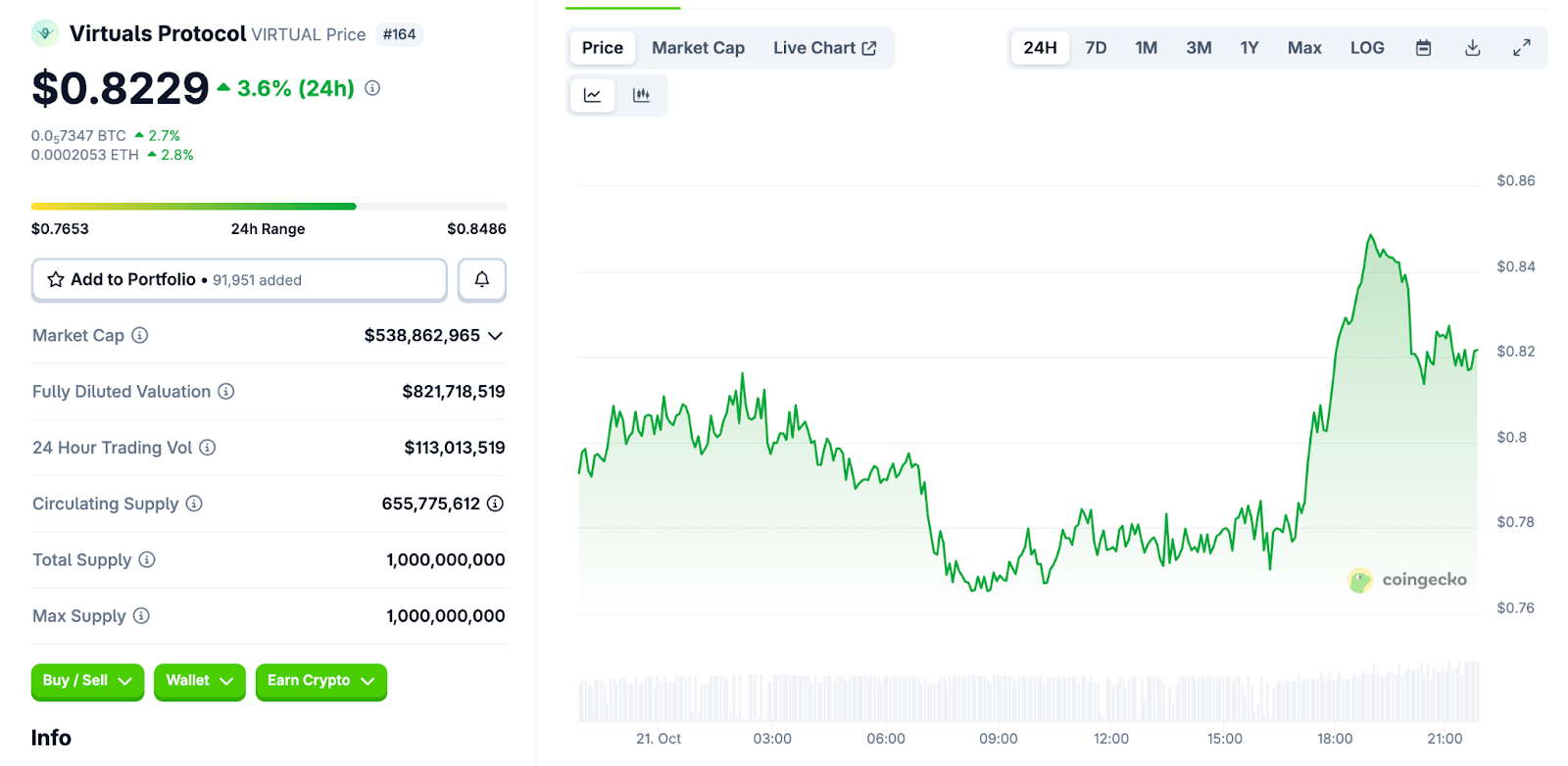
Risks and challenges
Despite the excitement surrounding AI crypto projects, investors should be aware of the potential pitfalls. The rapid growth of the sector brings not only new opportunities but also risks, from technical hurdles to market speculation and evolving regulations. Here are some of the key challenges facing AI-driven cryptocurrencies in 2025:
- Hype vs. reality: Many AI tokens rise on speculation before their tech matures. Prices can be volatile and subject to “boom and bust” cycles.
- Technical challenges: Building decentralized, scalable, and secure AI networks is complex. Not all projects will deliver.
- Data security: Privacy and misuse of AI or on-chain data are real concerns.
- Regulation: Legal frameworks around AI agents, data, and decentralized tokens are evolving and could impact adoption.
- Market volatility: As with all crypto, swings can be extreme. Careful research and risk management are essential.
From my own experience (and a few painful lessons), it’s easy to get swept up in buzzwords. Always test the product before you invest.
Conclusion
AI is poised to transform crypto, and the top AI coins of 2025 show real innovation and adoption in both infrastructure and applications. I’ve spent months watching these projects evolve, and while some will inevitably fall by the wayside, the real builders are making incredible progress. These projects are creating new markets for data, compute, and intelligent services, while making AI tools accessible to more users.
However, this sector is not without risks. Investors should research carefully, focus on working products, real users, and genuine AI integration over hype. If the fusion of AI and crypto fulfills its promise, these projects could be at the core of the next generation of decentralized technology.

Disclaimer: All materials on this site are for informational purposes only. None of the material should be interpreted as investment advice. Please note that despite the nature of much of the material created and hosted on this website, HODL FM is not a financial reference resource, and the opinions of authors and other contributors are their own and should not be taken as financial advice. If you require advice. HODL FM strongly recommends contacting a qualified industry professional.





